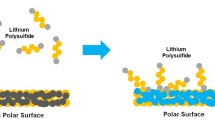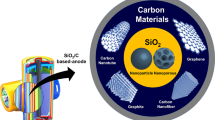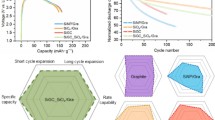Abstract
The synthesis of graphene materials in both high quality and quantity via economic ways is highly desirable and meaningful for practical applications. In this study, we reported the preparation of reduced graphene oxide (rGO) nanosheets in quantity via the anodic exfoliation of graphite in (NH4)2S2O8 aqueous solution. The proposed electrochemical exfoliation mechanism disclosed that SO4 −2 and O2 −2 could be intercalated into those graphite sheets, and rGO was obtained by the formation of gaseous SO2 and O2 within graphite sheets. The as-prepared sample is characterized by X-ray diffraction, Scanning electron microscopy Fourier transform infrared spectroscopy, transmission electron microscopy (TEM), Brunauer–Emmett–Teller (BET), cyclic voltammetry (CV), and electrochemical impedance spectroscopy (EIS) to confirm the formation of rGO. The XRD results indicated that the distance spacing of rGO was longer than that of graphite and the crystal structure of graphite was changed. The results of SEM exposed the random and ultrathin paper-like morphology of the rGO sheets. TEM images of rGO display interconnected sheet-like silky wave with wrinkled and clumped structure. We obtained the highest specific capacitance of 40.19 F/g for rGO at scan rate 50 mV/s. Our work has a bright future for large-scale rGO production intended for electrochemical energy storage.









Similar content being viewed by others
Data Availability
The raw/processed data required to reproduce these findings are included within the article.
References
M. Taghioskoui, Trends in graphene. Mater. Today 12(10), 34–37 (2009). https://doi.org/10.1016/S1369-7021(09)70274-3
M.J. Allen, V.C. Tung, R.B. Kaner, Honeycomb carbon: a review of graphene. Chem. Rev. 110, 132–145 (2010)
D. Cohen-Tanugi, J.C. Grossman, Water desalination across nanoporous graphene. Nano. Lett. 12(7), 3602–3608 (2012)
C.M. Xin Zhao, C. Hayner, H. Kung, In-plane vacancy‐enabled high‐power Si–graphene composite electrode for lithium‐ion batteries. Adv. Energy Mater. 1(6), 1079 (2011)
W. Hui, K. Sun, F. Tao, J. Dario Stacchiola, H. Yun Hang, 3D Honeycomb-like structured graphene and its high efficiency as a counter-electrode catalyst for dye-sensitized solar cells. Angew. Chem. Int. Ed. 52(35), 9210 (2013)
D. Prasai, J.C. Tuberquia, R. Robert, G. Harl, K. Jennings, I. Kirill, K.L. Bolotin, Graphene: corrosion-inhibiting coating. ACS Nano 6, 1102 (2012)
W.J. Hyun, O.O. Park, Foldable graphene electronic circuits based on paper substrates. Adv. Mater. 25(34), 4729 (2013)
Z. Radivojevic et al. (2012) Presented at proceedings of the 2012 virtual reality international conference, Laval, France
A. Bonanni, M. Pumera, Graphene platform for hairpin-DNA-based impedimetric genosensing. ACS Nano 5, 2356 (2011)
J. Yi, G. Choe, J. Park, J. Young, Graphene oxide-incorporated hydrogels for biomedical applications. Polym. J. (2020). https://doi.org/10.1038/s41428-020-0350-9
M.S.A. Bhuyan, M.N. Uddin, M.M. Islam, F.A. Bipasha, S.S. Hossain, Synthesis of graphene. Int. Nano Lett. 6(2), 65–83 (2016). https://doi.org/10.1007/s40089-015-0176-1
H. Saleem, M. Haneef, H.Y. Abbasi, Synthesis route of reduced graphene oxide via thermal reduction of chemically exfoliated graphene oxide. Mater. Chem. Phys. 204, 1–7 (2018). https://doi.org/10.1016/j.matchemphys.2017.10.020
Y.N. Sudhakar, H. Hemant, S.S. Nitinkumar, P. Poornesh, M. Selvakumar, Green synthesis and electrochemical characterization of rGO–CuO nanocomposites for supercapacitor applications. Ionics (2016). https://doi.org/10.1007/s11581-016-1923-7
D.B. Shinde, J. Brenker, C.D. Easton, R.F. Tabor, A. Neild, Shear assisted electrochemical exfoliation graphite graphene. Langmuir (2016). https://doi.org/10.1021/acs.langmuir.5b04209
D.X. He, W.D. Xue, R. Zhao, 2018 Aqueous solution of ammonium persulfate assisted electrochemical exfoliation of graphite into graphene. 658–662
L. Wu, W. Li, P. Li, S. Liao, S. Qiu, Powder, paper, and foam of few-layer graphene prepared in high yield by electrochemical intercalation exfoliation of expanded graphite. Small 10, 1421–1429 (2013). https://doi.org/10.1002/smll.201302730
K. Parvez, Z. Wu, R. Li, X. Liu, R. Graf, X. Feng, Exfoliation of graphite into graphene in aqueous solutions of inorganic salts. J. Am. Chem. Soc. (2014). https://doi.org/10.1021/ja5017156
M. Francis, K.L. Alcorn, D.L. Kuntz, C. Druffel, Scott, Warren aqueous intercalation of graphite at a near-neutral pH. ACS Appl. Energy Mater. 1, 5062–5067 (2018)
M. Coros, F. Pogacean, C. Socaci, G. Borodi, L. Magerus, R. Alexandru, Simple and cost-effective synthesis of graphene by electrochemical exfoliation of graphite rods. RSC Adv. 6, 2651 (2016)
C. Su, A. Lu, Y. Xu, F. Chen, A.N. Khlobystov, L. Li, High-quality thin graphene films from fast electrochemical exfoliation. ACS Nano 5, 2332–2339 (2011)
A.M. Abdelkader, A.J. Cooper, R.A.W. Dryfe, I.A. Kinloch, How to get between the sheets: a review of recent works on the electrochemical exfoliation of graphene materials from bulk graphite. Nanoscale 7, 6944–6956 (2015). https://doi.org/10.1039/C4NR06942K
R.M. Tamgadge, A. Shukla, Electrochimica Acta A pH-dependent partial electrochemical exfoliation of highly oriented pyrolytic graphite for high areal capacitance electric double layer capacitor electrode. Electrochim. Acta 325, 134933 (2019). DOI:https://doi.org/10.1016/j.electacta.2019.134933
K. Chen, D. Xue, Preparation of colloidal graphene in quantity by electrochemical exfoliation. J. Colloid Interface Sci. 436, 41–46 (2014). https://doi.org/10.1016/j.jcis.2014.08.057
K.S. Rao, J. Senthilnathan, Y. Liu, M. Yoshimura, Role of peroxide ions in formation of graphene nanosheets by electrochemical exfoliation of graphite. Sci. Rep. 4, 1–6 (2014). https://doi.org/10.1038/srep04237
C.A. Goss, J.C. Brumfield, E.A. Irene, R.W. Murray, Imaging the incipient electrochemical oxidation of highly oriented pyrolytic graphite. Anal. Chem. 65, 1378–1389 (1993)
I.-M. Low, H.M. Albetran, M. Degiorgio, Structural characterization of commercial graphite and graphene materials. J. Nanotechnol. Nanomater. 1(1), 23–30 (2020)
P.A. Mikhaylov, M.I. Vinogradov, I.S. Levin, G.A. Shandryuk, A.V. Lubenchenko, V.G. Kulichikhin, Synthesis and characterization of polyethylene terephthalate-reduced graphene oxide composites. IOP Conf. Ser.: Mater. Sci. Eng. 693, 012036 (2019). https://doi.org/10.1088/1757-899X/693/1/012036
S. Thakur, N. Karak, Green reduction of graphene oxide by aqueous phytoextracts. Carbon 50, 5331–5339 (2012)
D. Li, M.B. Muller, S. Gilje, R.B. Kaner, G.G. Wallace, Processable aqueous dispersions of graphene nanosheets. Nat. Nano 3(2), 101–105 (2008)
M. Cheng, L.J. Huang, Y.X. Wang, Y.C. Zhao, J.G. Tang, Y. Wang, Y. Zhang, M. Hedayati, M.J. Kipper, S.R. Wickramasinghe, Synthesis of graphene oxide/polyacrylamide composite membranes for organic dyes/water separation in water purification. J. Mater. Sci. 54, 6974 (2019). https://doi.org/10.1007/s10853-018-2828-9
W. Li, H. Zhang, L. Xia, Fabrication and characterization of ultrafine graphite/carbon foam composites. J. Porous Mater. 22, 565–570 (2015). https://doi.org/10.1007/s10934-015-9926-8
A. Shalaby, A. Shalaby, D. Nihtianova, P. Markov, A. Staneva, R.S. Iordanova, Y.B. Dimitriev, Structural analysis of reduced graphene oxide by transmission electron microscopy. Bulgarian Chem. Commun. 47, 291–295 (2015)
R. Siburian, H. Sihotang, S.L. Raja, M. Supeno, C. Simanjuntak, New route to synthesize of graphene nanosheets. Orient. J. Chem. (2018). https://doi.org/10.13005/ojc/340120
P. Sreekanth Perumbilavil, T. Sankar, P. Rose, R. Philip, White light Z-scan measurements of ultrafast optical nonlinearity in reduced graphene oxide nanosheets in the 400–700 nm region. Appl. Phys. Lett. 107, 051104 (2015). https://doi.org/10.1063/1.4928124
J.C. Silva Filho, E.C. Venancio, S.C. Silva, H. Takiishi, L.G. Martinez, R.A. Antunes, 1A thermal method for obtention of 2 to 3 reduced graphene oxide layers from graphene oxide. SN Appl. Sci. 2, 1450 (2020). https://doi.org/10.1007/s42452-020-03241-9
A. Ramadoss, B. Saravanakumar, S.J. Kim, Thermally reduced graphene oxide-coated fabrics for flexible supercapacitors and self-powered systems. Nano Energy 15, 587 (2015)
Y. Gonga, D. Lia, B. QiangFua, C. Pan, Influence of graphene microstructures on electrochemical performance for supercapacitors. Prog. Nat. Sci.:Mater. Int. 25, 379–385 (2015)
N. Vika Marcelina, S. Syakir, Y.W. Wyantuti, R. Hidayat, Characteristic of thermally reduced graphene oxide as supercapacitors electrode materials. IOP Conf. Ser.: Mater. Sci. Eng. 196:012034196(2017)
P.K. Jha, S.K. Singh, V. Kumar, S. Rana, S. Kurungot, N. Ballav, High-level supercapacitive performance of chemically reduced graphene oxide. Chem 3, 846–860 (2017)
X. Zhang, X. Ge, S.S.Y. Qu, W. Chi, C. Chen, W. Lü, Morphological control of RGO/CdS hydrogel for energy storage. CrystEngComm 18, 1090–1095 (2016)
Y.N. Sudhakar, H. Hemant, S.S. Nitinkumar, P. Poornesh, M. Selvakumar, Green synthesis and electrochemical characterization of rGO–CuO nanocomposites for supercapacitor applications. Ionics 23, 1267–1276 (2017)
M. Cristina Tanzi, S. Fare, G. Candiani, Organization, structure, and properties of materials. Found. Biomater. Eng. (2019). https://doi.org/10.1016/B978-0-08-101034-1.00001-3
I.M. Brashem, 2021 Why are graphite electrodes used in electrolysis? https://www.mbrashem.com/why-are-graphite-electrodes-used-in-electrolysis/ (Accessed Oct 07)
Acknowledgements
This work was financially supported by DST-SERB, New Delhi, with major sponsoring of the project [Grant Number (EEQ/2021/000633)] and The Institute of Science, Dr Homi Bhabha State University, Fort, Mumbai, MH, India.
Author information
Authors and Affiliations
Contributions
Conceptualization, methodology, investigation, data curation, and manuscript writing were performed by AK. Formal Analysis, validation, writing—original draft preparation were performed by ALJ. Data collection and formal analysis were performed by AK and ALJ. Writing—review and editing, supervision were performed by JMK and AVK. All authors have read and agreed to the published version of the manuscript.
Corresponding author
Ethics declarations
Conflict of interest
The authors declare that they have no conflict of interest.
Additional information
Publisher’s Note
Springer Nature remains neutral with regard to jurisdictional claims in published maps and institutional affiliations.
Rights and permissions
Springer Nature or its licensor (e.g. a society or other partner) holds exclusive rights to this article under a publishing agreement with the author(s) or other rightsholder(s); author self-archiving of the accepted manuscript version of this article is solely governed by the terms of such publishing agreement and applicable law.
About this article
Cite this article
Khan, A., Jadhav, A., Khobragade, J.M. et al. Extraction of excessively reduced graphene oxide from discarded dry cell batteries by anodic exfoliation method. J Mater Sci: Mater Electron 34, 62 (2023). https://doi.org/10.1007/s10854-022-09431-y
Received:
Accepted:
Published:
DOI: https://doi.org/10.1007/s10854-022-09431-y




